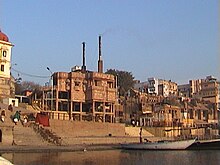The Varanasi Heritage Dossier/Karnataka and Harishcandra Ghats
Detailed description of each heritage Site - Prabhu Ghat to Kedara Ghat
Karnataka and Harishcandra Ghats


Location
[edit | edit source]25º 17.884’ North and 83º 00.446’ East (Ruru Bhairava at Karnataka Ghat).
Exact location on a map
[edit | edit source]Karnataka and Harishcandra Ghats
Area
[edit | edit source]0.29 ha
Historical/cultural/natural significance
[edit | edit source]Till the early 20th century Karnataka (or Mysore) Ghat was part of the Hanuman Ghat, however in ca 1915 the area of purchased by the Estate of Mysore (Karnataka) and developed as Ghat. There is a ‘pilgrims rest house’ (dharmashala) by the estate where majority of pilgrims from south India, especially Karnataka State get shelter. The stone slab lane divides the two ghats, i.e. Hanuman Ghat and Karnataka Ghat. At the bank side in a stone niche (madhi) there are dilapidated images of Sati and also an image of Ruru Bhairava. Ruru Bhairava is one among the eight who guards the inner sacred territory of Kashi; his old broken image has been replaced by the new one about a decade ago. -- The Harishcandra Ghat has been named after a great mythological king of the same name. According to ancient tales, he once worked the cremation ground here for the preservation of truth and charity but at the end the gods rewarded him and restored his lost throne and his dead son to him (cf. Matya Purana, 8). This is one of the two cremation ghats, and sometimes referred as Adi Manikarnika (“the original cremation ground”, cf. KKm 2.25-26); and still there exists Adi Manikarnika Tirtha. This is also the seat of old Harampapa water-tirtha.This ghat was not described in the ancient mythologies; and for the first time Prinsep (1822) and Sherring (1868), both mentioned this as Shmashana Ghat. It is speculated that when the city expanded towards south in abbreviated form cremation ghat has also been replicated, which is evident by the Sati images of 15th-16th century scattered near this ghat. It can easily be accepted that during 15th-16th century there was already an active cremation ground, as also described in the Kedara Amtaragriha Yatra (KKm). In ca 1741 Narayana Dikshita, a religious guru of the Peshvas, renovated this ghat and made it partly pucca. In a mid 18th century paintings preserved in Savai Mansingh-II Museum (Jaipur, Rajasthan) this ghat was referred as Shamashana Ghat. At the upper part in the shrines there are images of Harishcandreshvara, Rohiteshvara, Adi Manikarnikeshvara, and Vriddha Kedara. At the bank on the open tower is a linga of Shmasaneshvara. In 1988 an electric crematorium is opened, however side-by-side funeral on wood-fire is continuing; of course, rarely the electric crematorium functions due to shortage of power supply.

Present state of conservation
[edit | edit source]Except by the Karnataka State Trust is directly taking care of the palace and dharmashala, there are no specific action plans, programmes and strategies for conservation and preservation of the ghats. The trust maintains its properties according to their own perspectives without specific plans.
Specific measures being taken for conserving the specific property
[edit | edit source]It is expected that by the support of active people participation, awareness to save the age-old rich heritage, and development under the Master Plan (and its judiciary control) the ghat heritage will be protected and conserved for the better befit to the society.
Ownership
[edit | edit source]The specific properties along the ghat are owned by the respective temples and the trust and the persons living there; and the ghat area is owned by the Municipal Corporation.